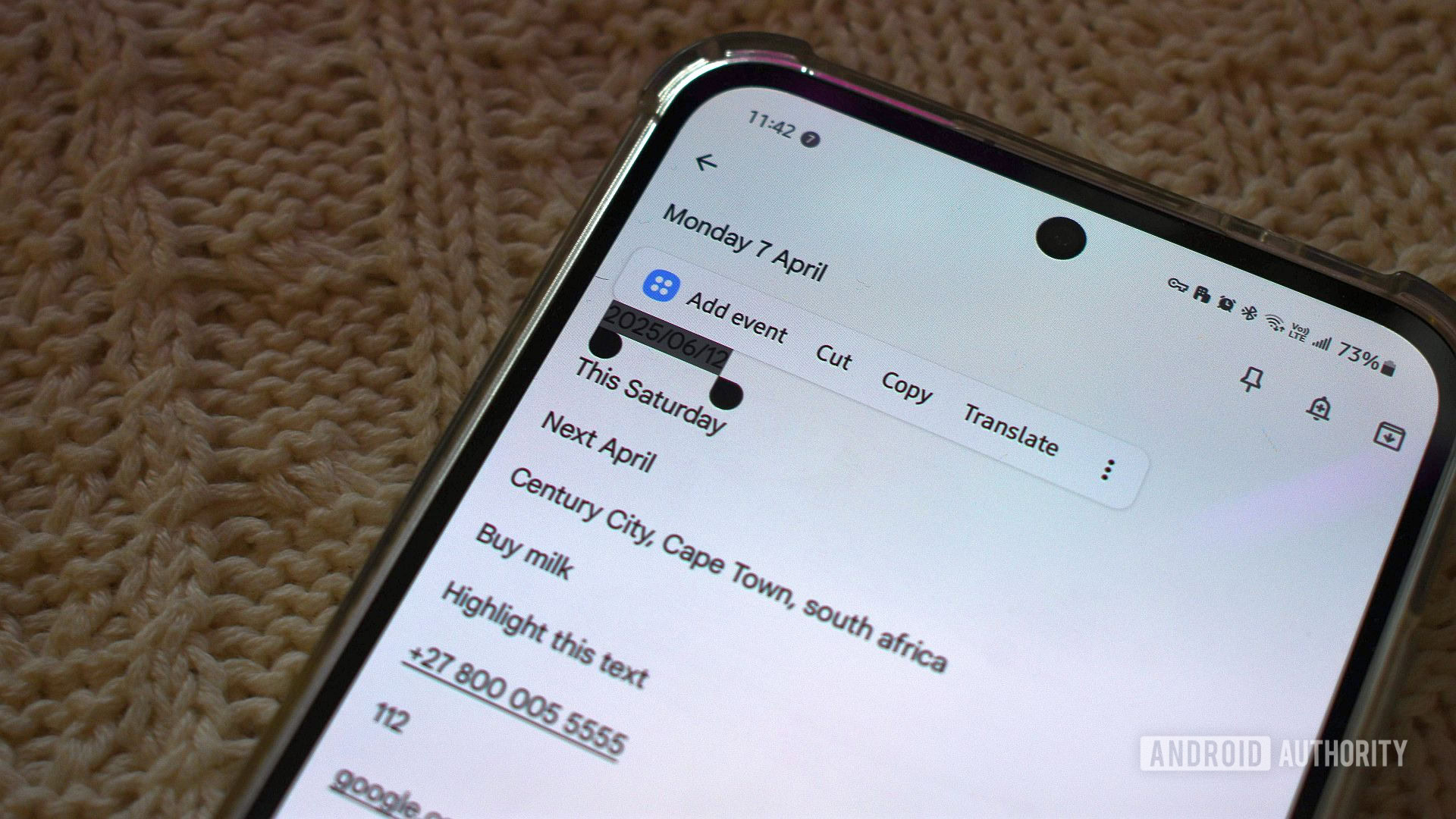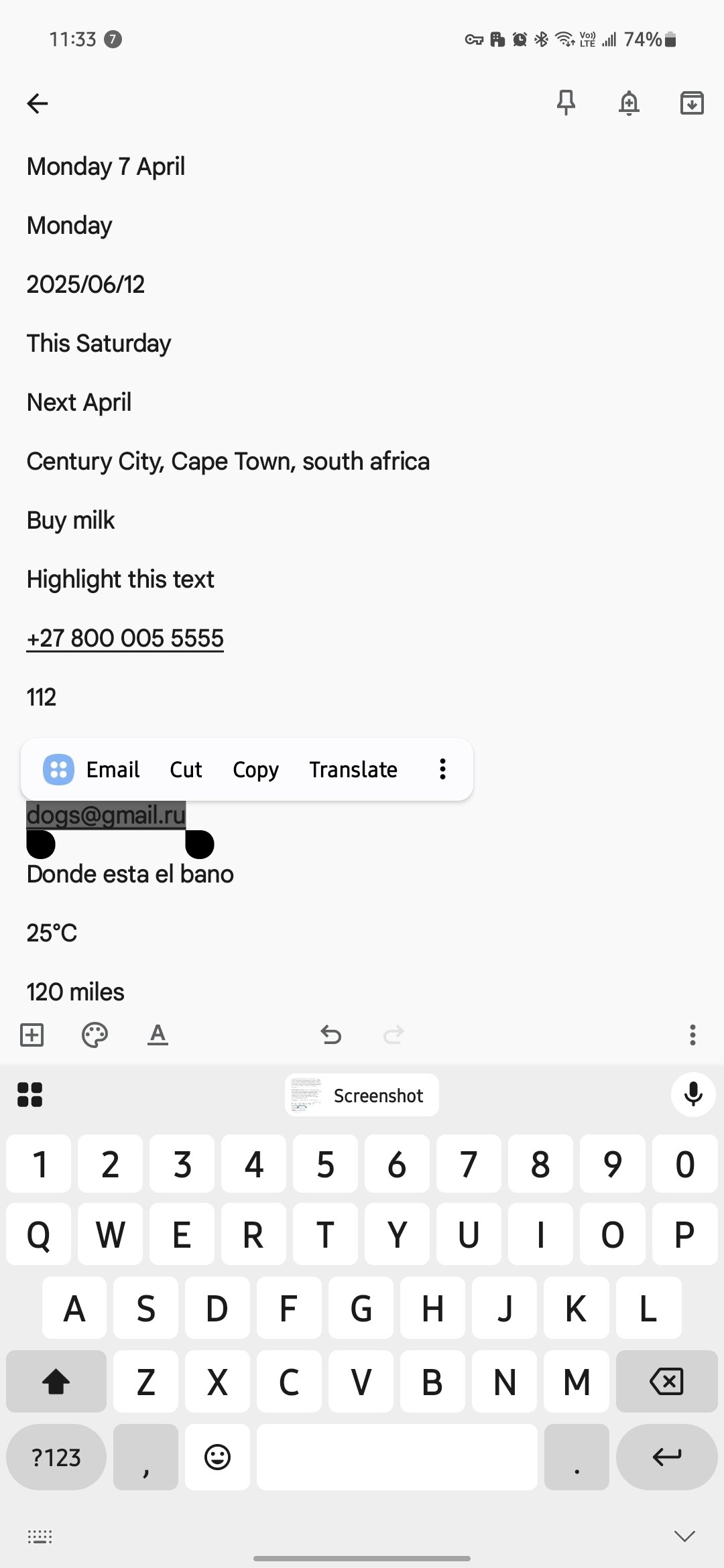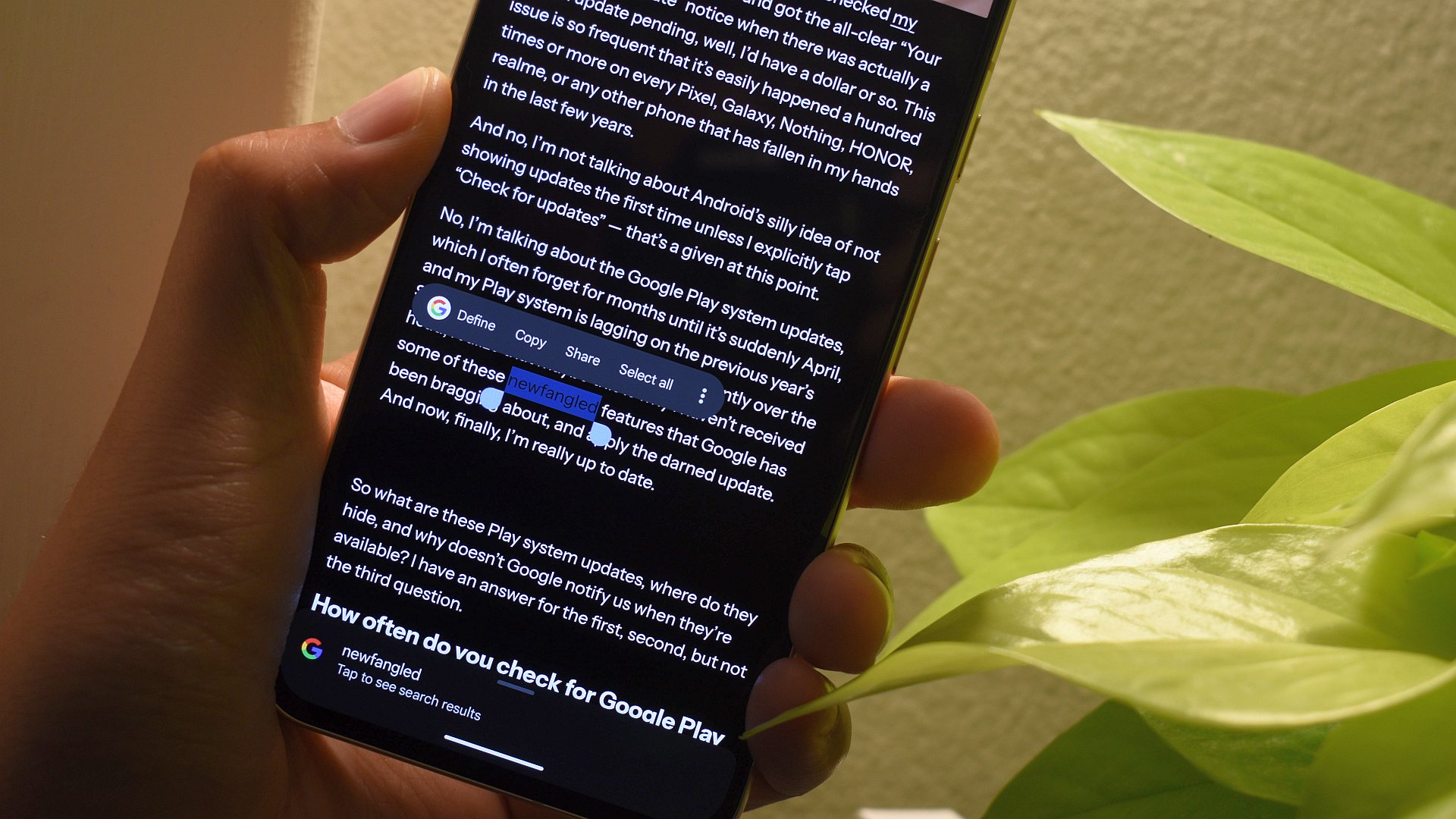Andy Walker / Android Authority
Shortcuts are everywhere on Android, and I use them daily to speed up my workflow. Long-time Android smartphone owners may be familiar with shortcuts that appear when icons are long-pressed or the various swiping gestures available that trigger a variety of other actions. But Android also hides a bevy of other shortcuts in a context menu when selecting text.
How often do you use Android’s text-selection shortcuts?
3 votes
What are these hidden Android shortcuts?
Before you run off selecting everything on your device, let me first define what I’m specifically referring to.
The shortcuts in question appear when a simple text string is highlighted within any app that supports them. As these shortcuts are tied to text, not a link or an icon (including the context and content of that text), a host of shortcut options can trigger. They’re great for skirting monotonous copy/paste tasks and extra menus and instead point me right to the app I want to open. Granted, this shortcut system has flaws, and I’ll be sure to cover those below, but first, I want to detail the examples I’ve added to my daily Android repertoire.
These contextual shortcuts appear specifically when you select text within a supported app.
For the most part, you’ll find a default list of shortcuts across the Android ecosystem, which usually includes Cut, Copy, Translate, Select all, with Share and Manage apps lurking behind the three-dot overflow button. These options differ broadly across devices. They also depend on which apps you’ve installed and which app you’ve selected the text.
Tapping Manage apps allows you to add apps to the shortcut list permanently. On my Galaxy S24 FE, this includes link checker URLcheck, smart browser Arc Search, and privacy browser Firefox Focus.
My favorite hidden text-selection shortcuts on Android

Andy Walker / Android Authority
As I’ve mentioned, I want to detail some of the specific, special shortcuts that I’ve added to my Android routine. These shortcuts go beyond the standard context menu shortcut list. Let me explain these below.
Physical addresses and place names
I often encounter place names and physical addresses on my device. Instead of manually performing a Google Maps search, I can select the text and tap the Map shortcut option that appears. This will produce the Open with menu listing apps that support addresses and locations. On my phone, these include navigation apps like Maps.me and OsmAnd, geographical apps like PeakFinder, and transport apps like Uber. Zoom Meetings appears too for some reason.
Notably, I find the Maps shortcut option doesn’t reliably trigger when highlighting every place name, which will become a theme as I progress through this guide. Sure, it recognizes a city, suburb, road name, country, and entire address strings, but it doesn’t seem to trigger on some landmarks. “JFK Airport” was one omission I found particularly puzzling.
Calendar dates
Confirming plans in messaging apps usually involves bouncing around ideas and dates between various users. Once I’ve confirmed a date with my friends, I can highlight the date string and tap on the Add event shortcut. I want to be clear: strings like “2025/04/07” support this shortcut, but other date formats are hit-and-miss.
The first time I tested this, “Monday 7 April” produced the Add Event shortcut. However, the second attempt to highlight that text produced a View shortcut instead. Presumably, this is because the date was now in the past — it’s an interesting little detail if so.
Less formal dates, like “This Saturday,” also triggers View. Tapping this opens the Calendar app on that given date. Interestingly, phrases like “Next April” don’t trigger any date-related shortcut.
Phone numbers
I can’t recall when I last used my phone as a phone, but when I do encounter a number, I can select it to trigger the Call shortcut. This works really well in browsers, but it’s unreliable in almost every other app.
For instance, highlighting phone numbers stored in Google Keep doesn’t trigger it (as a tradeoff, Keep hyperlinks the number). Additionally, five-digit SMS numbers used here in South Africa aren’t recognized as numbers.
Email addresses

Andy Walker / Android Authority
Finally! A reliable shortcut that’s predictable. Practically any string that includes an @ symbol and a .domain will produce the Email shortcut, even if it’s a real address or not. Tapping it will open up your preferred email client and set the address as your recipient. It works across multiple apps, too, from third-party browsers to Google Keep.
Text within Google apps and definitions
You can easily trigger a Google Search of any selected text in Google apps. This is another incredibly reliable shortcut to trigger.
A good example of this is selecting text within the Discover feed. In addition to the Search shortcut in the contextual menu, a shortcut bar also appears at the bottom of the screen. While you won’t find the shortcut in Chrome’s context menu, the bar does appear. It’s another design quirk, but one that doesn’t affect functionality all that much.
Additionally, the Define shortcut is among the most frustrating to use. It appears when highlighting a handful of words that seem completely random. The shortcut opens a Google app search result of the word selected prefaced by “Define”. In short, it’s effectively an extension of the shortcut I described above, but it’s far less reliable.
To emphasize my point, the Define shortcut appeared when I highlighted “southern” and “occupies” in an article by The Guardian running in Google News. However, selecting “international law” within the same article triggered nothing. In another article I tested, the shortcut appeared when I highlighted “fossilized” and “dinosaur” but not “paleontologist.”
Web links
Thankfully, web links are recognized in a far more consistent manner. (Almost) any web address that includes .domain will trigger an Open shortcut option. Notably, tapping this will trigger your default browser, not an Open with box. In my case, that’s URLcheck.
Translate
Translate appears on practically every text string that’s selected, and that’s very handy. However, the one annoying aspect of this shortcut is its reliance on the dictionaries you have installed on your device.
I could translate from English to Spanish because my phone has the latter dictionary stored (I’m not sure why), but it wouldn’t to Afrikaans as it lacked that database. It’s strange that this feature wouldn’t leverage Google Translate itself to offer online translations.
Measurement conversions
This is one of my favorite text selection shortcuts, and I use it as often as I bake (which, while often, probably isn’t often enough.) Select a temperature, distance, weight, or volume, and a Convert shortcut will appear. Tap it, and conversions in metric and imperial measurements will appear in a box. You can also tap Show more to expand the list of options. It’s swift, predictable, and infinitely useful.
Other shortcuts
If I were to detail all the text-based shortcuts available on Android, we’d be here all day, but I want to touch on some other third-party app-related shortcuts that offer up their own functionality.
One example I use often is Inoreader’s Annotate and Create Highlighter options and Pocket’s Highlight shortcuts. Both allow me to bring attention to a piece of text in an article.
Browsers like Firefox offer Ask shortcuts, which allow further research of a particular text string in another app, like Firefox Focus, Arc Search, or Perplexity.
On my Samsung phone, Microsoft offers a handful of shortcuts, too. There’s an option to save blocks of text using Microsoft’s 365 Note, while Samsung provides a shortcut to Samsung Pass in certain situations.
Android’s text shortcuts are brilliant but so inconsistent

Andy Walker / Android Authority
I love that Android offers these text-selection shortcuts, but the feature feels unfinished, unpolished, and largely forgotten by Google.
I often have to guess which shortcut will trigger based on the text I select, which makes it far more likely that I’ll manually copy/paste information into my app of choice rather than relying on the context menu. Will it recognize “LAX” as a place? Will it define “squirrel”? Will it realize this obvious phone number is a phone number? Selecting text just to discover what’ll happen goes against the shortcut’s time-saving purpose. It’s not intuitive, which discourages its use.
For the most part, I believe Google can improve the context menu’s usability without revolutionizing it. I want the option to reorder shortcuts as I see fit, and provide the full breadth of possible options for any given slice of text. Granted, I don’t expect the Convert shortcut to appear while highlighting an email address, but I expect the Translate option to appear when selecting a French dish or Define to trigger on any word.
I love using text-selection shortcuts, but Google really needs to streamline the inefficiencies and reduce the guesswork.
I’d also appreciate Google gifting the bulk of its own products shortcuts of their own. I’d really like to save chunks of text to Google Keep via a shortcut, for instance.
Does this mean you shouldn’t use the shortcuts that are already available? Not at all. When they work, they’re incredibly useful, and I believe they’ll improve your smartphone workflow just as they have mine.
If there’s a text-selection shortcut that you use often or particularly like that I didn’t mention above, please tell me more about it in the comments section.


